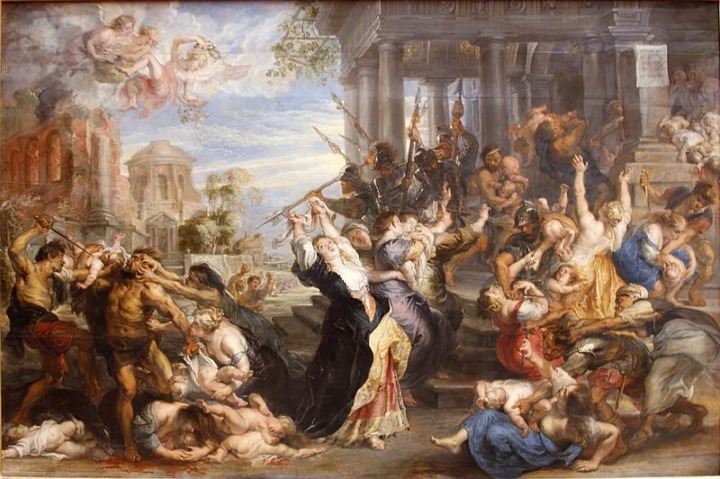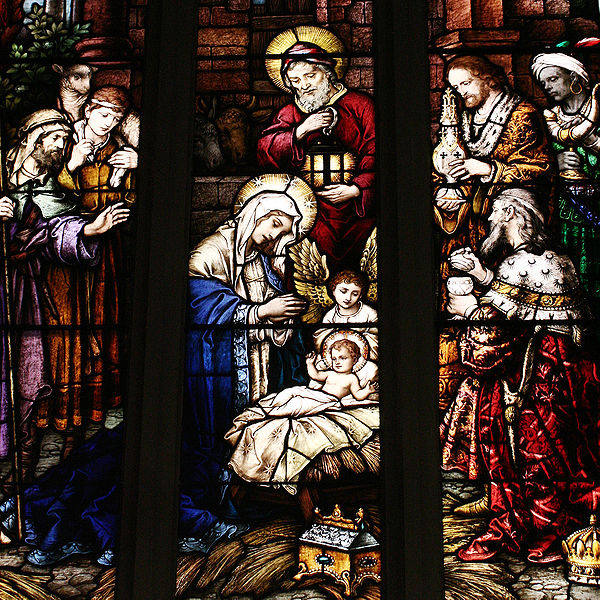「クリスマス・シーズン」になると、通りはイルミネーションで彩られ、店は赤や緑のクリスマス・カラーで飾られる。ラジオをつければ、クリスマス・ソングとサンタクロースの歌ばかり流れる。興奮は12月25日の朝に最高潮に達し、その後、ピタッと静かになる。クリスマスが終わって新年が始まり、人々は通常の生活に戻る。
[toggle] Sometime in November, as things now stand, the “Christmas season” begins. The streets are hung with lights, the stores are decorated with red and green, and you can’t turn on the radio without hearing songs about the spirit of the season and the glories of Santa Claus. The excitement builds to a climax on the morning of December 25, and then it stops, abruptly. Christmas is over, the New Year begins, and people go back to their normal lives. [/toggle]しかし、伝統的なキリスト教のクリスマスのお祝いは正反対だ。アドベントはクリスマスの4週間前の日曜日に始まり、ほぼ1カ月間、クリスチャンは待ち望む心でキリストの到来に備え、期待の賛美歌を歌う。そして12月25日、クリスマスの日は、その後12日にわたるお祝いの日の先駆けとなり、それは1月6日のエピファニー(主の公現の祭日)で終わる。
[toggle] The traditional Christian celebration of Christmas is exactly the opposite. The season of Advent begins on the fourth Sunday before Christmas, and for nearly a month Christians await the coming of Christ in a spirit of expectation, singing hymns of longing. Then, on December 25, Christmas Day itself ushers in 12 days of celebration, ending only on January 6 with the feast of the Epiphany. [/toggle]この時期、世俗的なカレンダーではなく、キリスト教のカレンダー(典礼暦、教会暦)に従うことを勧めるのは当たり前のことだ。しかし多くの場合、注目はアドベントの期間に注がれ、12日間のクリスマスは二の次にされる。ほとんどの人は、12月25日からお祝いをするには、あまりにも疲れ果てている。
[toggle] Exhortations to follow this calendar rather than the secular one have become routine at this time of year. But often the focus falls on giving Advent its due, with the 12 days of Christmas relegated to the words of a cryptic traditional carol. Most people are simply too tired after Christmas Day to do much celebrating. [/toggle]「本物の」12日間のクリスマスは、私たちの生活の中で「受肉」とはどういうことかを思い巡らすために重要だ。クリスマスは人類史上、最も重要な出来事を記念する日なのだ。自らが造った世界へ神が赤ん坊として入ってこられたことを記念する出来事を。
[toggle] The “real” 12 days of Christmas are important not just as a way of thumbing our noses at secular ideas of the “Christmas season.” They are important because they give us a way of reflecting on what the Incarnation means in our lives. Christmas commemorates the most momentous event in human history—the entry of God into the world he made, in the form of a baby. [/toggle]世界はキリストによって造られたが、そのキリストが私たちの中に住まわれた。カトリックのミサにおけるクリスマスの祈りの一つは、すべてのクリスチャンにとってクリスマスが意味することを要約している。「驚くべきわざで人間を創造し、さらにそれを回復された神よ。私たちの人間性を分かち合うために、自らへりくだられたキリストの神性を、私たちは分かち合います」。キリストにおいて私たちの人間性は神と結びつき、キリストが私たちの心の中に入ってくださるとき、キリストは私たちをその結びつきへと導いてくださる。
[toggle] The Logos through whom the worlds were made took up his dwelling among us in a tabernacle of flesh. One of the prayers for Christmas Day in the Catholic liturgy encapsulates what Christmas means for all believers: “O God, who marvelously created and yet more marvelously restored the dignity of human nature, grant that we may share the divinity of him who humbled himself to share our humanity.” In Christ, our human nature was united to God, and when Christ enters our hearts, he brings us into that union. [/toggle]クリスマスに続く3つの伝統的な祝日(5世紀後半にさかのぼる)は、受肉の神秘がキリストの体の中でどう成就したのか、それぞれ異なったあり方を考えさせてくれる。
[toggle] The three traditional feasts (dating back to the late fifth century) that follow Christmas reflect different ways in which the mystery of the Incarnation works itself out in the body of Christ. [/toggle]
ケルン大聖堂のステンドグラス「聖ステファノの殉教」
12月26日は「ステファノの祝日」で、貧しい人々に奉仕する伝統的な日だ(クリスマス・キャロル「慈しみ深き王ウィンセスラス」は、ステファノの祝日に貧しい農民に施しをした王について歌っている)。ステファノは最初の執事の一人として、貧しい人へキリストの愛を示す人々の先駆者だった(使徒6章)。しかし、何よりも彼は新約の最初の殉教者であり、命をささげることによりキリストを証しした(同7章)。
12月27日は福音書記者ヨハネの祝日であり、ヨハネは12弟子のうちで殉教しなかったただ一人の弟子だ。それよりもむしろヨハネは、自分の言葉で「受肉」を証言し、ギリシア哲学を覆して、「言は肉となって、わたしたちの間に宿られた。わたしたちはその栄光を見た」(ヨハネ1:14)と断言した。
[toggle] December 26 is the feast of St. Stephen—a traditional day for giving leftovers to the poor (as described in the carol “Good King Wenceslas”). As one of the first deacons, Stephen was the forerunner of all those who show forth the love of Christ by their generosity to the needy. But more than this, he was the first martyr of the New Covenant, witnessing to Christ by the ultimate gift of his own life. St. John the Evangelist, commemorated on December 27, is traditionally the only one of the twelve disciples who did not die a martyr. Rather, John witnessed to the Incarnation through his words, turning Greek philosophy on its head with his affirmation, “The Word was made flesh, and dwelt among us” (John 1:14, KJV). [/toggle]
ルーベンス「幼児虐殺」
12月28日は、ヘロデに殺害された幼児殉教者の祝日だ。彼らはステファノのように、キリストに栄光を帰すような英雄的な殉教者ではなかった。またヨハネのように、いのちの言葉を語り、神の神秘を理解するような霊感もなかった。知識や意思を持つ前に不条理のうちに死んだのだが、それでも彼らはキリストのために死んだ。人間の不公平によって苦しみ、死んでいく人々が経験する長い苦悶を、私たちは彼らのうちに見る。彼らは、自分が贖(あがな)われたことを知らなかった。もしキリストが彼らのために来られたのでなかったら、キリストが来られたことに意味はない。
[toggle] On December 28, we celebrate the feast of the Holy Innocents, the children murdered by Herod. These were not martyrs like Stephen, who died heroically in a vision of the glorified Christ. They were not inspired like John to speak the Word of life and understand the mysteries of God. They died unjustly before they had a chance to know or to will—but they died for Christ nonetheless. In them we see the long agony of those who suffer and die through human injustice, never knowing that they have been redeemed. If Christ did not come for them too, then surely Christ came in vain. [/toggle]幼児殉教者を祝うとき、中絶や戦争、虐待の犠牲者を覚える。キリストの到来が、最も希望のない人に希望をもたらすという信仰を私たちは新たにする。そして私たちは、殺された幼子のように、自らの行いや知識によってではなく、ただキリストの憐れみによってのみ救われると、可能な限り飾り気のない言葉で告白する。
[toggle] In celebrating the Holy Innocents, we remember the victims of abortion, of war, of abuse. We renew our faith that the coming of Christ brings hope to the most hopeless. And, in the most radical way possible, we confess that like the murdered children we are saved by the sheer mercy of Christ, not by our own doing or knowing. [/toggle]中世には、これら3つの祝日は、さまざまな聖職者のためにささげられた。ステファノは助祭の守護聖人だ。福音記者ヨハネの祝日は司祭のためにささげられ、幼児殉教者の祝日は、聖職者になるべく訓練されて祭壇の奉仕をする若者にささげられた。そしてその後、信仰とはかけ離れた馬鹿げた慣習とこれらの祝日は結びつけられていった。
[toggle] In the Middle Ages, these three feasts were each dedicated to a different part of the clergy. Stephen, fittingly, was the patron of deacons. The feast of John the Evangelist was dedicated to the priests, and the feast of the Holy Innocents was dedicated to young men training for the clergy and serving the altar. The sub deacons (one of the “minor orders” that developed in the early church) objected that they had no feast of their own. So it became their custom to celebrate the “Feast of Fools” around January 1, often in conjunction with the feast of Christ’s circumcision on that day (which was also one of the earliest feasts of the Virgin Mary, and is today celebrated as such by Roman Catholics). [/toggle] [toggle] The twelve days of Christmas saw similar celebrations of the topsy-turvy and the unruly. A “Lord of Misrule” was often elected at Christmas and ruled the festivities until Epiphany. A schoolboy was traditionally chosen as bishop on December 6 (the Feast of St. Nicholas) and filled all the functions of bishop until Holy Innocents’ Day. The Christmas season also sometimes saw the “Feast of the Ass,” commemorating the donkey traditionally present at the manger. On this day, people were supposed to bray like a donkey at the points in the Mass where one would normally say “Amen.” [/toggle]これらの慣習をすべて異教の生き残り(それらの多くはそうだ)、または無関係で無害な愚行として片づけるのは簡単だ。確かに中世の教会は、これらの慣習の大部分に眉(まゆ)をひそめ、16世紀の宗教改革者はそれらをやめさせる働きを成し遂げた。
しかし、キリストのメッセージが「世界中を騒がせてきた」とテサロニケの異教徒が言ったように(使徒17:5)、ここには熟考に値するメッセージがある。イエスを誕生させることで神は、「権力ある者をその座から引き降ろし、身分の低い者を高く上げ、飢えた人を良い物で満たし、富める者を空腹のまま追い返されます」(ルカ1:52~53)。
[toggle] It is easy to dismiss all these customs as pagan survivals (which many of them are), or at best as irrelevant and harmless follies. Indeed, the medieval church frowned on most of these practices, and the Reformers of the 16th century finished the job of suppressing them. But perhaps there’s a message here worth pondering—that in the words of the horrified pagans of Thessalonica, the message of Christ turns the whole world upside down. In the birth of Jesus, God has put down the mighty from their seats and exalted the lowly. He has filled the hungry with good things and sent the rich away empty. [/toggle]再び安全で正常になるということは何もない。私たちは「神の愚かさに従う」よう招かれていると、マイケル・カードは語る。しかし逆説的に、この最大の革命家は反逆者なのではない。神の律法の驚くべき意味を明らかにし、それにもかかわらず、モーセの教えに従って割礼を受けるよう服従させてきた人間の伝統をガラリと変えたのだ。
[toggle] Nothing will ever be safe or normal again. In the words of Michael Card, we are called to “follow God’s own fool.” And yet, paradoxically, this greatest of revolutionaries was not a rebel. The one who revealed the surprising meaning of God’s Law and turned the tables on human traditions nonetheless submitted to be circumcised according to the teaching of Moses. [/toggle]
聖ミカエル大聖堂(トロント)のステンドグラス
最後に、エピファニー(1月6日)でクリスマスのお祝いが終わる。エピファニーは、福音が告げ知らされることの始まりを祝う。キリストがこの世に現れたことが、東方の三博士の訪問、イエスの洗礼、水をぶどう酒に変えるという3つの異なる出来事によって示される。西方の伝統では三博士が支配的だが、東方の教会ではイエスの洗礼が主題になる傾向がある。
[toggle] Finally, on Epiphany (January 6), the celebration of Christmas comes to an end. “Twelfth Night” (as all lovers of Shakespeare know) is the ultimate celebration of Christmas madness (Shakespeare’s play features one of his many “wise fools” who understand the real meaning of life better than those who think they are sane). Epiphany commemorates the beginning of the proclamation of the gospel—Christ’s manifestation to the nations, as shown in three different events: the visit of the Magi, the baptism of Jesus, and the turning of water into wine. In the Western tradition, the Magi predominate. But in the Eastern churches, Jesus’ baptism tends to be the primary theme. [/toggle] [toggle] In the Bucharest subway, children leading lambs walk through the trains in commemoration of the Lamb of God to whom John pointed. Orthodox Christians traditionally have their homes blessed with holy water on or around this day. Nowhere is Epiphany celebrated more joyously than in Ethiopia. Pilgrims from all over the country converge on the ancient city of Aksum, where they bathe in a great reservoir whose waters have been blessed by a priest. [/toggle]エピファニーはしばしば忘れられた祭りだ。しかし、クリスマス・シーズンの真の最終点としてエピファニーは、私たちを世に送り出す。受肉を実現し、暗闇の中でキリストの光を証しするために。イエスに従って、私たちはイエスの死と復活の中へと洗礼を受けた。殉教者か、預言者的な証し人か、あるいは単に日常生活の喜びと悲しみの中で信仰的に生きる者として召されているのか。いずれにせよ私たちは、キリストを通して贖われ、神に結びつけられたという尊厳を覚えて、すべての日々を生きていく。
[toggle] Epiphany is often a forgotten festival (although, by the accident of Edwin’s mother’s birthday falling on January 5, his very un-liturgical family preserved the ancient tradition of keeping the Christmas decorations up until Epiphany). As the true end-point of the Christmas season, however, Epiphany sends us into the world to live out the Incarnation, to witness to the light of Christ in the darkness. Following Jesus, we have been baptized into his death and resurrection. Whether we are called to martyrdom, or to prophetic witness, or simply to faithful living in the joys and sorrows of our daily lives, we live all of our days in the knowledge of our dignity, redeemed through Christ and united to God. [/toggle]私たちは、根底から覆された世界に生きる、世間とは違った団体の一員であり、この逆説的な真実を証しするために外に出ていく。
[toggle] We are part of the strange society of people whose world has been turned upside down, and we go out to witness to this topsy-turvy truth: “The Word was made flesh, and dwelt among us: and we beheld his glory … and of his fullness have we all received, and grace for grace” (John 1:14, 16). [/toggle]言は肉となって、わたしたちの間に宿られた。わたしたちはその栄光を見た。……わたしたちは皆、この方の満ちあふれる豊かさの中から、恵みの上に、更に恵みを受けた。(ヨハネ1:14、16)
執筆:エドウィンとジェニファー・ウッドラフ・テイト
本記事は「クリスチャニティー・トゥデイ」(米国)より翻訳、転載しました。翻訳にあたって、多少の省略をしています。
出典URL:https://www.christianitytoday.com/history/2008/august/real-twelve-days-of-christmas.html
